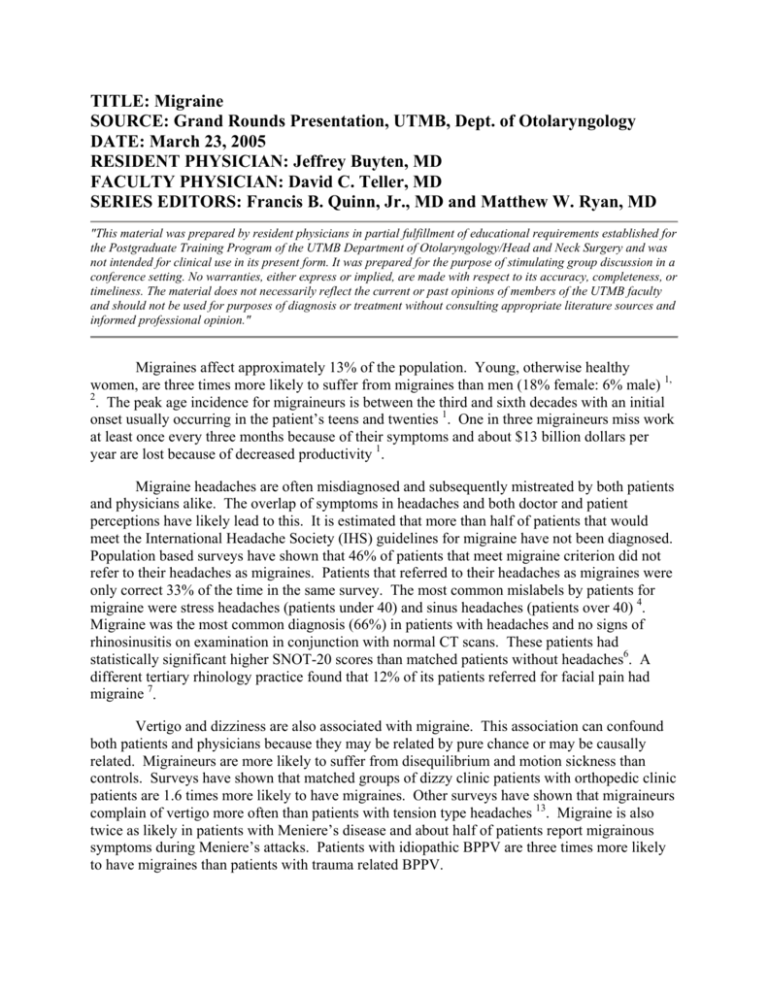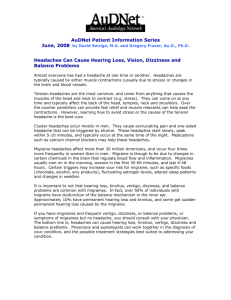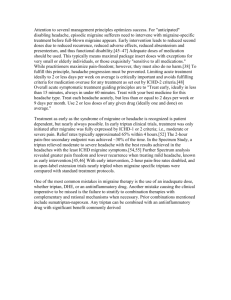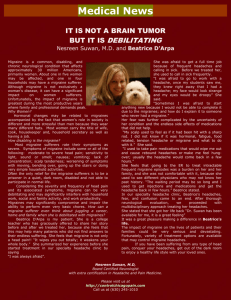Migraine - Preppers
advertisement

TITLE: Migraine SOURCE: Grand Rounds Presentation, UTMB, Dept. of Otolaryngology DATE: March 23, 2005 RESIDENT PHYSICIAN: Jeffrey Buyten, MD FACULTY PHYSICIAN: David C. Teller, MD SERIES EDITORS: Francis B. Quinn, Jr., MD and Matthew W. Ryan, MD "This material was prepared by resident physicians in partial fulfillment of educational requirements established for the Postgraduate Training Program of the UTMB Department of Otolaryngology/Head and Neck Surgery and was not intended for clinical use in its present form. It was prepared for the purpose of stimulating group discussion in a conference setting. No warranties, either express or implied, are made with respect to its accuracy, completeness, or timeliness. The material does not necessarily reflect the current or past opinions of members of the UTMB faculty and should not be used for purposes of diagnosis or treatment without consulting appropriate literature sources and informed professional opinion." Migraines affect approximately 13% of the population. Young, otherwise healthy women, are three times more likely to suffer from migraines than men (18% female: 6% male) 1, 2 . The peak age incidence for migraineurs is between the third and sixth decades with an initial onset usually occurring in the patient’s teens and twenties 1. One in three migraineurs miss work at least once every three months because of their symptoms and about $13 billion dollars per year are lost because of decreased productivity 1. Migraine headaches are often misdiagnosed and subsequently mistreated by both patients and physicians alike. The overlap of symptoms in headaches and both doctor and patient perceptions have likely lead to this. It is estimated that more than half of patients that would meet the International Headache Society (IHS) guidelines for migraine have not been diagnosed. Population based surveys have shown that 46% of patients that meet migraine criterion did not refer to their headaches as migraines. Patients that referred to their headaches as migraines were only correct 33% of the time in the same survey. The most common mislabels by patients for migraine were stress headaches (patients under 40) and sinus headaches (patients over 40) 4. Migraine was the most common diagnosis (66%) in patients with headaches and no signs of rhinosinusitis on examination in conjunction with normal CT scans. These patients had statistically significant higher SNOT-20 scores than matched patients without headaches6. A different tertiary rhinology practice found that 12% of its patients referred for facial pain had migraine 7. Vertigo and dizziness are also associated with migraine. This association can confound both patients and physicians because they may be related by pure chance or may be causally related. Migraineurs are more likely to suffer from disequilibrium and motion sickness than controls. Surveys have shown that matched groups of dizzy clinic patients with orthopedic clinic patients are 1.6 times more likely to have migraines. Other surveys have shown that migraineurs complain of vertigo more often than patients with tension type headaches 13. Migraine is also twice as likely in patients with Meniere’s disease and about half of patients report migrainous symptoms during Meniere’s attacks. Patients with idiopathic BPPV are three times more likely to have migraines than patients with trauma related BPPV. The IHS criteria for migraine with aura require 3 out of 4 of the following 2, 3: 1. One or more fully reversible aura symptoms indicate focal cerebral cortical or brainstem dysfunction. 2. At least one aura symptom develops gradually over more than 4 minutes. 3. No aura symptom lasts more than one hour. 4. Headache follows the aura with a free interval of less than one hour and may begin before or with the aura. The IHS criteria for migraine without aura 2, 3: 1. Headache for 4-72 hours. 2. Headache with at least two of the following symptoms: • Unilateral location • Pulsating quality • Moderate to severe intensity. • Aggravated by routine physical activity. 3. During a headache at least one of following occurs: • Nausea and/or vomiting. • Photophobia. • Phonophobia. The majority of migraines are associated with auras (80%). Auras are progressive neurologic deficits or disturbances that typically precede attacks but can occur simultaneously with the headache and may linger afterwards. Auras that last for more than an hour are rare but may indicate more complicated migraines. Visual symptoms are the most common followed by paresthesias of the lips, lower face and fingers. Symptoms include flickering lines, numbness, possible unilateral weakness of the upper extremities and possible aphasia. Prodromes associated with migraines last hours to weeks and are associated with mood instability, appetite changes and fluid retention. In common migraines, following the aura or prodrome, patients develop a throbbing, deep pain that is unilateral most cases (70%) but can be bilateral 3. The pain crescendos and is worsened by motion, exertion, light, and noise 3. The headache usually limits normal function, both mental and physical due to its intensity 8. Other symptoms include focal facial pain, cutaneous allodynia, GI dysfunction, facial flushing, lacrimation, rhinorrhea, nasal congestion and vertigo 3, 5, 6, 7, 8, 9. Attacks can be precipitated by stress (social or physiologic), menses, foods (dairy, red wine, nuts, shellfish, caffeine withdrawal), vasodilators, olfactants, poor sleep hygiene and bright lights 2. There are several migraine subtypes which may be preceded by auras as well. The basilar type migraine affects the brainstem and patients can suffer dysarthria, vertigo, diplopia, tinnitus, hearing loss and ataxia. The visual symptoms are more likely to be bilateral. In ocular or retinal migraines, patients develop unilateral scotomata or blindness that lasts less than an hour. Hemiplegic migraine is associated with familial migraine syndromes and is manifested by motor and sensory symptoms that completely recover sometime after the headache has resolved. Menstrual migraines occur in the days spanning two days prior to and three days after the onset of menstruation 3. Migrainous vertigo is a migraine subtype in which vertigo may be the prevailing or sole symptom 3. Benign paroxysmal vertigo of childhood is thought to be its early manifestation in which patients develop sudden vertigo attacks and go on to develop migraines at a later age (usually without aura). Patients report both spontaneous and positional vertigo with varied duration and sometimes subtle association with more common migraine symptoms. The IHS does not recognize migrainous vertigo as a distinct entity. Proposed diagnostic criteria for migrainous vertigo • • Recurrent episodic vestibular symptoms of at least moderate severity. One of the following: • Current of previous history of IHS migraine. • Migrainous symptoms during two or more attacks of vertigo. • Migraine-precipitants before vertigo in more than 50% of attacks. • Response to migraine medications in more than 50% of attacks. The etiology of migraine headaches is still not well defined but there are at least three main mechanisms involved in its pathogenesis: extracranial arterial vasodilation, extracranial neurogenic inflammation and decreased inhibition of central pain transmission 8. The brainstem has been implicated as the pivotal area of dysfunction that leads to migraines. The neurovascular theory assumes that the central nervous system responds abnormally to stimuli, setting forth a reaction that activates the trigemino-vascular system and ultimately leads to sterile neurogenic inflammation 8, 9. Neurogenic inflammation is caused by release of substance P, Calcitonin gene-related peptide and neurokinin A. Calcitonin gene related peptide is a potent vasodilator expressed in the trigeminal ganglion and has been shown to be increased in acute attacks 3. The frontal branch of the superficial temporal artery is most frequently affected vessel, which corresponds to pain in the temples. Local pain thresholds are decreased by neurogenic inflammation, which is manifested as cutaneous allodynia. Central pain inhibition may be related to increased endogenous opioids in the CSF 8. The mechanism of auras is thought to be related to cortical spreading depression (CSD), which is a self propagating wave of slowly traveling cortical inhibition. CSD may activate trigeminal afferents and alter blood- brain permeability 3. CSD is associated with a decrease in cerebral blood flow during auras. The role of serotonin in migraine pathogenesis is not well delineated but it is one of the main pharmacologic targets in therapy. Serotonin levels and activity have been shown to decrease during acute attacks and serotonin synthesis has been shown to up-regulate between attacks 3. The treatment of migraine headaches may be approached using several strategies: aborting the attacks at their onset, controlling the pain once is fully evolved and reducing the frequency of attacks. Therapies aimed at aborting an attack should be started as soon as the premonitory or warning signs are noted. Abortive therapy has been revolutionized with the introduction of 5-hydroxytryptamine (5-HT) receptor agonists. These include sumatriptan (Imitrex) available in oral, subcutaneous injection or nasal spray forms, naratriptan (Amerge), rizatriptan (Maxalt) and zolmitriptan (Zomig) all available in oral preparations. These medications have allowed the migraine sufferer to quickly and effectively treat attacks several times a month with minimal side effects. Other medications used to abort headaches include ergotamine tartrate administered sublingually, or in combination with caffeine by mouth. Dihydroergotamine 45 is administered in a nasal spray. Butorphanol is a mixed narcotic agonist/antagonist available by nasal spray. It does have potential for abuse and chronic use is contraindicated. Midrin is an orally administered compound of acetaminophen, isometheptene mucate, a sympathomimetic amine and dichloralphenazone, a mild sedative. It has a low side effect profile and may be used until relief is attained. Many NSAIDs have been shown to be effective in migraine headaches. The short-rise time, short-acting medications such as naproxen, ketorolac, ibuprofen and choline magnesium trisalicylate have the greatest usefulness. Lidocaine administered intranasally in 4% spray, either singly or in combination with nasal decongestants, has been shown to be effective, although of short duration. Intravenous lidocaine with diphenhydramine may also be effective 10. Effective abortive treatment has been shown to reduce headache recurrence and also decreases the associated symptoms. Different abortive care strategies have been used in treatment. Stepped care starts with low dose analgesics and progresses to vasoconstrictors, opioids, and then triptans depending on symptom severity and success of prior treatments. Stratified care adjusts treatment according to headache intensity but is limited when attacks are severe because of decreased GI absorption of meds due to gastric atony. Staged care is the most optimal approach because it attempts to treat headaches according to their intensity and the time at which they occur. Patients keep a headache diary and then a treatment plan with backup therapies is given 8. If abortive therapy fails, management should be aimed at reducing the intensity of the pain and controlling associated symptoms such as nausea and vomiting. It is desirable to avoid opiates for the treatment of migraine. Finkel et. al. recommend several treatment regimens: (1) prochlorperazine (Compazine) IV push that may be repeated in 20 minutes if no effect, (2) dihydroergotamine IV push followed by IV prochlorperazine, (3) chlorpromazine (Thorazine) IV push, may repeat in 20 minutes if needed and (4) haloperidol IV push followed by lorazepam IV push. Options (1) and (3) should not be combined, but may be followed by (2) or (4) if necessary 10. Patients experiencing 4 or more attacks per month should be started on a prophylactic regimen. Appropriate first steps are to limit the activities or factors that trigger the headaches. This may be effective by itself, but medical prophylaxis is often needed as well. Multiple antidepressant medications have been shown to be effective in the prevention of migraine headache. These include amitriptyline, nortriptyline, doxepin, trazodone, imipramine and desipramine. The newer selective serotonin re-uptake inhibitors (SSRI) including Prozac and Zoloft, have not been shown to be effective in migraine therapy. Bellergal, a low dose, sustained relief ergotamine may be useful in preventing attacks. NSAIDs have some usefulness in the prevention of attacks as well as the treatment of the acute headache. β-blockers, specifically propranolol, nadolol, atenolol, timolol and pindolol have been used with some success but are contraindicated in patients with depression, asthma or diabetes. Calcium channel blockers (verapamil, nifedipine, nimodipine) have shown some effectiveness preventing migraine attacks as well 10. Overall, effective prophylactic therapy should reduce migraine frequency by 40 – 60%. When headaches do occur, they become easier to abort as well 8. Binder et al. found 51% of migraine sufferers obtained complete prophylaxis for an average of 4.1 months duration after the injection of botulinum toxin type A (BOTOX) into the facial and scalp musculature. An additional 38% obtained a partial response for an average duration of 2.7 months. The investigators also reported a 70% complete response rate among patients treated acutely for migraine headache within 1-2 hours post-treatment. These results hold promise for a novel treatment modality for the migraine sufferer 10, 12. A randomized controlled study demonstrated that patients that suffered chronic daily headaches showed improvement in symptoms after botox injection to the facial muscles 11. Migraines are a debilitating, chronic disease that afflicts millions. Recognition of common symptoms and understanding of both patient’s and physicians misperceptions regarding headaches is key to correctly diagnosing and treating the disorder. Otolaryngologists should be aware of the overlap of symptoms with common otolarygologic disorders and consider migraine in their differential diagnoses. Bibliography 1. Landy, S. Migraine throughout the Life Cycle: Treatment through the Ages. Neurology. 2004; 62 (5) Supplement 2: S2-S8. 2. Bailey, BJ. Head and Neck Surgery – Otolaryngology 3rd Edition. 2001. Pgs. 221-235. 3. Bajwa, ZH, Sabahat, A. Pathophysiology, Clinical Manifestations, and Diagnosis of Migraine in Adults. Up To Date online. 2005. 4. Lipton, RB, Stewart, WF, Liberman, JN. Self-awareness of migraine: Interpreting the labels that headache sufferers apply to their headaches. Neurology. 2002; 58(9) Supplement 6: S21-S26. 5. Cady, RK, Schreiber, CP. Sinus headache or migraine?: Considerations in making a differential diagnosis. Neurology. 2002; 58 (9) Supplement 6: S10-S14. 6. Perry, BF, Login, IS, Kountakis, SE. Nonrhinologic headache in a tertiary rhinology practice. Otolaryngology – Head and Neck Surg 2004; 130: 449-452. 7. Daudia, AT, Jones, NS. Facial migraine in a rhinological setting. Clinical Otolaryngology and Allied Sciences. 2002; 27(6): 521-525. 8. Spierings, EL. Migraine mechanism and management. Otolarynogol Clin N Am 36 (2003): 1063 – 1078. 9. Avnon, y, Nitzan, M, Sprecher, E, Rogowski, Z, and Yarnitsky, D. Different patterns of parasympathetic activation in uni- and bilateral migraineurs. Brain. 2003; 126: 16601670. 10. Stroud, RH, Bailey, BJ, Quinn, FB. Headache and Facial Pain. Dr. Quinn’s Online Textbook of Otolaryngology Grand Rounds Archive. 2001. http://www.utmb.edu/otoref/Grnds/HA-facial-pain-2001-0131/HA-facial-pain-2001.doc 11. Ondo, WG, Vuong KD, Derman, HS. Botulinum toxin A for chronic daily headache: a randomized, placebo-controlled, parallel design study. Cephalalgia 2004 (24): 60-65.



